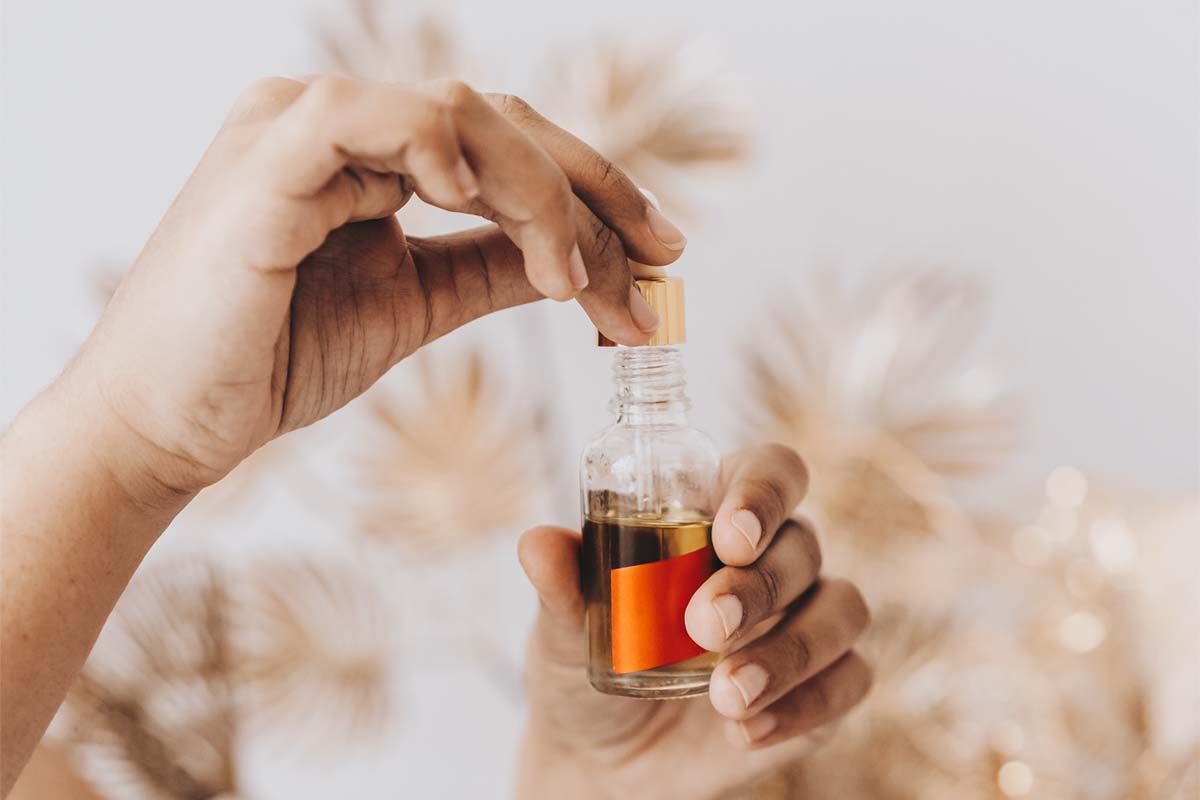Table of Contents[Hide][Show]
In the journey of skin care, choosing between a facial oil and a moisturizer is one of the most common dilemmas. While both aim for soft, supple skin, they work in very different ways. Think of a moisturizer as an “all-in-one” solution, providing both water for hydration and oil to soften the skin. A facial oil, on the other hand, is a specialist, focusing entirely on nourishing with oil and creating a robust protective seal.
So, does your skin need the all-in-one solution or the protective specialist? Can they replace or perfectly complement each other? This article will clarify that core difference, helping you to confidently choose and use them optimally to achieve your healthiest skin.
Understanding the Roles of Facial Oil and Moisturizer
Before we can choose, it’s essential to understand the fundamental nature of each product. They feel and act differently for a reason, as they are formulated to perform distinct yet complementary tasks in caring for your skin.
Moisturizers: Your Skin’s Hydrating and Surface-Protecting Friend
- Key characteristics: A moisturizer is typically an emulsion—a balanced blend of water-based ingredients (for hydration) and oil-based ingredients (for moisturizing and locking in moisture). This complex structure allows it to perform multiple jobs at once.
- Mechanism of action: A good moisturizer works in three ways. It contains humectants like glycerin or aloe vera to draw water into the upper layers of the skin, providing a plump feeling. It contains emollients to soften and smooth the skin’s surface. And it often contains some occlusives to form a thin film that helps retain that moisture. Choosing a moisturizer suitable for one’s skin characteristics is an important first step.
- Quick note on serums vs. face creams: While both serums and face creams can contain a mix of water- and oil-based ingredients, they’re designed with different goals in mind. Serums typically have a higher concentration of lightweight, hydrating ingredients—like humectants—that draw water into the skin and deliver targeted actives deep below the surface. Face creams, on the other hand, focus on both hydration and moisturization, pairing water-attracting agents with emollients and occlusives to soften the skin and lock in moisture. In short, serums feed the skin with hydration and actives, while creams seal and protect that hydration.
Facial Oils – The Essence of Nourishment and Barrier Reinforcement

- Key characteristics: Facial oils, true to their name, are entirely oil-based. They are a concentrated, water-free formula packed with the essential fatty acids, vitamins, and natural antioxidants your skin craves.
- Mechanism of action: A facial oil works primarily on the epidermis. With its lipid components, it can penetrate to deeply nourish, effectively strengthening the skin’s natural lipid barrier. This barrier is crucial for locking in moisture (preventing trans-epidermal water loss – TEWL), soothing, and protecting from external factors. High-quality facial oils can make a noticeable difference to the skin.
Moisturizers (like face creams) and facial oils are both important but serve different roles. Face creams typically provide both water (hydration) to plump and oil (moisturization) to soften and seal the skin’s surface. Facial oils (which are also moisturizers), being 100% oil-based, focus on deep nourishment with lipids, reinforcing the skin barrier, and more intensely locking in moisture.
Can Facial Oil Be a Moisturizer and When Can They Be Used Interchangeably?

This is perhaps the most debated question. To answer it accurately, we need to revisit the role of each product.
Facial oils are moisturizers and possess excellent moisturizing properties as they help prevent trans-epidermal water loss and soften the skin effectively. However, they differ from other types of moisturizers (such as face creams), which usually also contain hydrating agents. Whether a face oil is ‘better’ than another moisturizer like a face cream largely depends on your specific skin type and needs at any given time. For instance, very dry skin might find oils more effective at retaining moisture, while skin needing both hydration and moisturization might require a face cream, or even both.
When a Facial Oil Might Suffice as Your Only Moisturizer
In some cases, a high-quality facial oil can absolutely serve as your sole moisturizing step, especially when:
- You have oily or not overly dry skin and prefer a lighter layer of nourishment. Your skin already has a good amount of natural lipids, so a light layer of oil may be all you need to nourish and protect.
- You have applied a deeply hydrating serum beforehand. The serum has provided the “water” element, and the oil will act as the perfect seal to lock in that hydration.
- You are in humid weather conditions. The humid air reduces the natural water loss from your skin.
- You prefer a dewy finish for your makeup application.
When to Use Both a Facial Cream Moisturizer and a Facial Oil

Combining both is a powerful strategy for providing the most comprehensive care, especially when:
- Your skin is dry, very dry, or mature and needs maximum hydration and lipid barrier support. The synergy between a cream’s blend of hydration and moisturization in addition to an oil’s sealing ability can be transformative. For example, layering an oil like our Rejuvenating Facial Oil with a cream like our Restorative Facial Cream creates a protective and nourishing cocoon. Plus, the oil addition can slick the product across the face more smoothly, offering a beautiful middle ground between velvety and dewy for a balanced finish.
- You are in dry or harsh weather conditions. Cold wind, dry air, and indoor heating can all strip moisture from the skin. To avoid common moisturizing mistakes that can quickly age your skin, understanding when to layer both is crucial.
Choosing the Optimal Facial Oil or Moisturizer for Your Skin
Making the right choice isn’t just about which texture you prefer; it’s about responding to your skin’s true needs. By combining knowledge of your skin type with mindful observation, you can find the perfect match.

Suggestions Based on Skin Type and Specific Concerns
- Dry/Mature Skin: This skin type often lacks both water and oil, so it usually benefits from using both. Look for richer-textured facial cream moisturizers and nutrient-dense facial oils to provide maximum nourishment and protection. Even if you are using a serum beforehand, including both a facial oil and facial cream afterwards can truly offer aging skin the support it needs.
- Oily/Combination Skin: You may prefer one over the other. If you choose a moisturizer, look for a lightweight, formula that provides hydration without feeling heavy. If you opt for an oil, look for a light, balancing facial oil (e.g., hazelnut, grapeseed) that can help tame the look of excess oil.
- Sensitive Skin: Reading the ingredient list is key—especially for sensitive skin. Creams often contain more ingredients because they require emulsifiers to blend water and oil. Oils, on the other hand, can provide deep moisturization with simpler formulas, making them a great option for those with delicate skin. For example, our Herbal Facial Oil for Sensitive Skin combines a base of grapeseed oil with sacha inchi oil, helping to soothe sensitivity while minimizing the appearance of fine lines and wrinkles. That’s not to say facial creams are off-limits—they just require a more careful eye on ingredients to reduce the risk of irritation. Whether you prefer an oil or a cream, choose products with calming ingredients and avoid synthetic fragrances or common irritants.
Listening To and Understanding Your Own Skin
No expert knows your skin better than you do. Encourage yourself to observe and feel your skin’s response. Some days your skin might crave the rich protection of an oil, while other days it might only need a light layer of cream. Finding the product or combination that feels most comfortable and effective is the ultimate goal. If you’re seeking natural, organic skin care options, you can explore our moisturizer collection and facial oils for inspiration.
How to Incorporate Facial Oil and Moisturizer into Your Skin Care Routine

Understanding the “what” is half the journey; mastering the “how” is what brings it all together. Layering isn’t a chore, but a mindful art that allows each product to reach its full potential.
The Golden Order for Optimal Nutrient Absorption
Always follow the “thinnest to thickest” principle for effective product penetration. This ensures water-based products can absorb before oil-based products create a seal.
- If using both: Apply serum, then facial cream moisturizer first (to deliver water and water-soluble ingredients), followed by facial oil (to “seal” in that moisture and provide further lipid nourishment).
- Alternatively: You can mix your facial cream with your facial oil for a balance of a silky and dewy application.
Smart Tips to Enhance Skin Care Efficacy
- Create a Custom Super-Moisturizer: On days your skin feels extra parched, try mixing a few drops of facial oil into your favorite facial cream moisturizer. This instantly boosts its emollience for a richer application.
- Embrace the Nightly Ritual: Consider using facial oil more generously in your nighttime skin care routine. This is when your skin is in its natural repair and regeneration mode, allowing for deep absorption and rejuvenation without interference from makeup or sunscreen.
Age-Specific Skin Care With Oils and Moisturizers
Skin’s needs change with age. In your 30s, maintaining optimal hydration with a serum and following with a suitable facial oil for added protection is a smart move. By your 40s, skin often requires richer moisturizers and facial oils with ingredients that support against aging signs. You can alternate between your facial cream and facial oil. From your 50s onward, using both can be a great way to support skin. Deeply nourishing and restorative facial cream moisturizers and facial oils become essential to help maintain skin’s radiance and vitality.
To build an optimal skin care routine for this stage, you can find more specialized tips in our article on skin care in your 30s. Similarly, understanding the changes and needs of your skin as you enter your forties will help you make more effective product choices; discover more at skin care in your 40s.
Building Your Perfect Moisture Ritual

The debate between facial oil and moisturizer isn’t about choosing a winner. Instead, it’s about recognizing two valuable allies in your skin care cabinet, each offering distinct benefits. A moisturizer is the all-in-one solution, providing both water and oil. A facial oil is the protective specialist, focusing on lipid nourishment and sealing in moisture.
The truly “better” option is whichever is most suitable for your skin type, concerns, and even your environment at any given time. They can work beautifully independently or complement each other in perfect harmony. By arming yourself with knowledge and listening to your skin’s signals, you can confidently build a comprehensive skin care routine. Embrace and enjoy this process of self-care—your skin will surely thank you for it.
Quick FAQs
Do dermatologists recommend facial oils?
Yes, many dermatologists and estheticians recommend facial oils, especially for those with a compromised skin barrier or dry skin. They recognize the ability of oils to deliver essential fatty acids, soothe the skin, and effectively lock in moisture. The key, as they often emphasize, is choosing the right oil for your skin type (e.g., lightweight for oily skin) and listening to how your skin responds.
What are the disadvantages of applying oil on the face?
The main potential disadvantages usually stem from using the wrong type of oil for your skin or applying too much. These can include:
- A greasy feeling: If the oil is too heavy or too much is applied.
- Clogged pores: If a heavy oil is used on already congested skin.
- A lack of hydration: If an oil is used alone on dehydrated skin without a hydrating serum or cream underneath.
These issues are easily avoided with careful selection and moderate application.
Can I mix my moisturizer and facial oil together?
Absolutely! This is a wonderful way to customize your routine. Mixing a few drops of your facial oil into your moisturizer in your palm instantly creates a richer, more emollient cream. This is especially helpful on days your skin feels extra dry or during the harsh winter months.








Leave a Reply